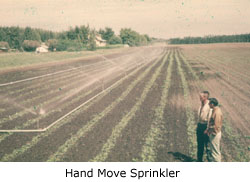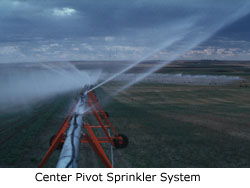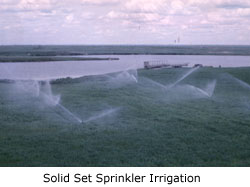Irrigation Methods
Sprinkler Irrigation

Hand-Move
Hand-move systems are either completely portable or semi-portable; in the latter, the pump and
main
line are permanently located. The main disadvantage of a hand-move is the higher labor
requirement for
moving the pipe. A particular type of hand-move is the towline system. Equipped with skids at
each
coupler, the sprinkler line (lateral) is end-towed by truck or tractor from one set to the next.
Giant Sprinklers
A giant sprinkler system consists of one or more large sprinklers discharging from 450 to 1000
litres a
min ute over an area of 60 metres or more in diameter. Their disadvantages include the high cost
of
operation caused by the pressures required to operate the sprinklers, and the high rate of
application
and poor uniformity of water application under windy conditions.
Side-Roll
In this system, the lateral is usually four-tenths of a kilometre long, mounted
on wheels $1.5 to $1 metres in diameter and spaced 12 metres apart. The lateral is moved from
one set
to the next by a power unit that rotates the pipe, which serves as the axle. The common power
unit is
an air-cooled gasoline engine in the centre of the lateral. The procedure, when moving to the next
set, is
to disconnect the lateral from the main line, walk to the power unit, move the lateral, return to the
main
line and reconnect.
The side-roll is very popular because the annual operating cost is about the same as for a hand-
move. Its
main disadvantage is its limitation to low growing crops, because the pipe is only about one
metre above
the ground.
Centre-Pivot
In this system, the water supply is delivered to the centre of a quarter section and the lateral,
usually
four-tenths of a kilometre long, is self-propelled in a circle around the central pivot point. The
lateral is
supported on two-wheeled or tracked towers, usually spaced 30 metres apart.
There are four methods of powering the system:
- Hydraulic water drive, either piston or sprinkler type;
- Hydraulic oil drive;
- Electrical drive;
- Air drive.

The towers along the lateral are kept in position by an alignment system that speeds up a
lagging tower or reduces the speed of one that gets ahead. The transport units on the towers can
be
swung 90 degrees so the lateral can be end-towed.
Sprinklers along the lateral are graduated in size so that a constant depth of water is applied along
its length. The depth of water applied is adjusted by selecting the length of time required per
revolution,
which can vary from a few hours to several days. The pressure required at the pivot is about 550
kilopascals and the capacity of the system varies in the range of 3,410 to 5,000 litres per minute.
Because the lateral is 2.1 to 2.7 metres above the ground, the centrepivot can be used on high
crops.
Square-Matic
The 'square-matic' is a straight-lateral, selfpropelled, continuously moving system This method
provides
better uniformity at a lower rate of application and complete coverage of a field, including the
corners.

Solid Set Sprinkler Irrigation
Because of their high cost, solid-set systems are limited to use with speciality crops such as
orchard and
truck crops. Within this group there are several different types of systems. The permanent variety
may
feature a complete network of buried lines and fixed sprinklers, or the sprinklers may be the
moveable
turf type. Portable solid-sets have their pipelines on the surface to allow greater ease of
movement.
Another type of solid-set system, the sequencing valve or "sequi-matic", is characterized by a
sequencing valve on
each sprinkler riser. A controller device allows each sprinkler to be activated independently.
Travelling Sprinklers
In a traveller system, a giant sprinkler is mounted on a trailer and moved continuously by a
winch. The
winch is powered by a water turbine, using the flow of
water to the sprinkler, or by a small engine. Most common travelling sprinklers are fed by a
flexible
hose from a main line. Travellers are limited to medium-textures and coarser soils because of
their high
rate of application.
Subsurface Irrigation
A recent innovation is the sophisticated, expensive, subsurface method of irrigation using small
diameter
plastic pipe with small openings. The principle is that the water flow is very slow, a rate equal to
that
used by the plant, so the water is fed continuously and directly to the root. The advantages are
better
soil-moisture conditions for the plant and no loss from evaporation because the surface soil is not
wet.
The disadvantages are the need for very careful screening of the water to avoid plugging of
openings;
excessive downward movement of water unless soil is fine textured; and possible problems of
salinity.
Because of the high costs it is generally limited to greenhouse or highly specialized crops.


